"In this film record set in the beautiful Cumbrian countryside, sheep shearing and other farming activities take second place to fun. Whether swimming and splashing in a stream, feeding lambs, or taking a rowing boat out on the lake, there is plenty to keep children - and adults - busy. And of course we mustn't forget that essential outdoor activity - a picnic in the sunshine and fresh air." (BFI Player)
"Whitehall Newsreel featuring : Morecambe Baths opened on 27th July 1936, with a civic ceremony and female models. Followed by footage of football in Christy Park (Morecambe) then General Evangeline Booth addressing a crowd; cuts to firemen and the gutted timber yard of Hustler's Sawmills; cuts to Remembrance service and procession. Finishes with dancers dressed as sailors. Interspersed with seafront shots." (NWFA Online Archive)
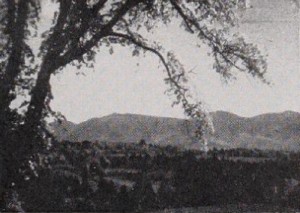
"Hamilton H. Jones has again shown his marvelous ability to combine beautiful movies and fine music on the double turntable into a cinematic whole that, in New England Autumn, carries an audience through the calm delight of fall days to a climax that has great dignity and spiritual stimulation. We see autumn in its most restful and wistful mood, and the action is slowly paced in harmony with the dying year. There is leisurely strolling in the many hued woods. The leaves on the ground are scuffed through and gently scattered. We see the things that we all like to do in the forests in autumn. Finally, in an arresting sequence of autumn fruits — great, gleaming pumpkins and ruddy apples — the music turns to the inspiriting old Dutch hymn of thanksgiving. Rising first orchestrally and then voiced by a thousand singers, the chorus ends as our eyes are lifted to the simple spire of a New England church. Here is suavity, here is intelligent movie making and here are dignity and spiritual uplift." Movie Makers, Dec. 1947, 534.
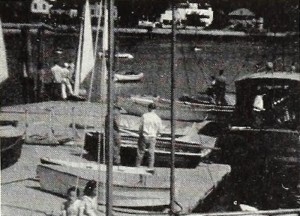
"Lester F. Shaal demonstrates, in New England Frames, what editing of existing footage can achieve. He has compiled from scenes of numerous sections of the Northeast a record of the year's seasons. Although the opening sequence of a train departing in a snowstorm seems to presage a more dramatic theme than that which follows, Mr. Shaal has captured the flavor of the New England countryside in all its seasonal beauty. Particularly competent in the winter sequence are the smooth follow shots of skiers. A little streamlining in the overall coverage would not have impaired the attractions of even this land of the early settlers." Movie Makers, Dec. 1950, 468.
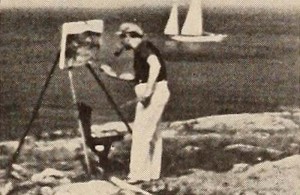
"New England Holiday is the kind of travel film any movie maker should be proud to produce. Replete with human interest and a warm feeling of good fun, this two reel record is distinguished by a wealth of splendid compositions and natural camera treatment. Albert F. Watts has lavished on such typically New England subjects as Gloucester harbor, the fishing fleet or a clam bake the sensitive feeling of an artist for line and mass and the alert understanding of cinematics of a genuine movie maker. Smoothly integrated sequences have been edited with unerring suavity and liveliness, comprising a whole which is both vital and lovely to look at. The production is fundamentally weakened only by a selection of title wordings considerably less spirited and effective than the films which they accompany." Movie Makers, Dec. 1938, 620.
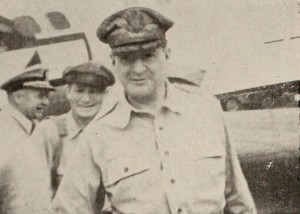
"When Lewis B. Sebring. jr., went from the United States early in 1942. as a war correspondent accredited to General Douglas MacArthur's headquarters, he wisely left his camera at home. There was no telling what dangers and difficulties lay ahead. Months later, after the Japanese had been driven back across the Owen Stanley Mountains, after the battles of Buna, Salamaua and others, there seemed to be more time and opportunity for personal movie making. Happily, Mr. Sebring managed to borrow a good 16mm. camera, and New Guinea Newsreel is one of the exciting results. Keyed by the expert titles of a news writer, it presents a series of well rounded sequences on such colorful subjects as a visit by General MacArthur; a cine interview with Major Richard I. Bong, top American air ace of the war to date; an informal exhibition of Japanese souvenirs, and a moving Easter service, somber against the gray dawn of a New Guinea foreshore." Movie Makers, Dec. 1944, 496.
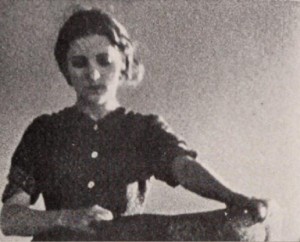
"In New Horizon, Cinematographer Clardy presented the life of a farm girl at a moment of crisis. One reel, almost without titles, tells the story of her efforts to marry the man she loves in spite of her father's opposition which keeps her chained to the farm." American Cinematographer, Feb. 1935, 78.
"Clardy was the winner last year of the gold medal for scenario and photography. Last year Clardy's picture was based on a western theme, while this year his scenario, although set in its greater part in the outdoors had several indoor shots. However, most to be admired was the way in which he handled his production both from composition and directorial standpoint. There were only three people in his cast with the girl assuming the major role. His sense of dramatic values, and especially his fine feeling for the proper tempo brought forth unstinted praise from the judges." American Cinematographer, Dec. 1934, 365
"A New Life for Jennifer is the sensitive story of a little girl about 4 years of age who is hard of hearing. She is enrolled in a special school for hard of hearing children where she learns to talk and speak correctly and in other ways to manage herself. The techniques used in theses teaching processes are emphatically depicted, and the judges did well in awarding to the maker of this film a citation which reads "For Special Service in the Public Interest" PSA Journal, Sept. 1965, 51.
"Film is an animated cartoon, which was produced by Charles E. Phillips" Archives of Ontario.
"Those who have not attended a New Orleans funeral may look forward to an experience. These are colored funerals for lodge members and important persons. Lodge brothers and sisters dress in their fraternal regalia. Men in uniform, braid, sashes, aprons, plumed hats, swords, long coats. Women in white uniforms or long skirts and complimentary headgear. The choice of dress befits the occasion. The Eureka Brass band Furnishes the music-fast marches to the funeral home, dirges to the cemetery, hymns at the graveside. Leaving the grave, jazz music is played as it is propitious to celebrate, a good time for dancing. Many impromptu dances set up along the return route. to hear the band music is enough to get one to attend a New Orleans funeral. The beat is almost hypnotic" PSA Journal, Oct. 1962, 36.
Total Pages: 299